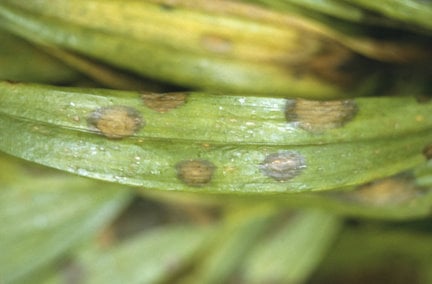
Quick facts
Common name - Various
Scientific name - Various
Plants affected - Lilies
Main causes - Fungi and viruses
Timing - Spring to summer
What are lily diseases?
Diseases that attack lilies can lead to unsightly flowers or foliage. They may also cause rotting in the . Lilies may be affected by;
- Lily disease – caused by the fungal leaf pathogen Botrytis elliptica
- Soil-borne fungal pathogens – Fusarium oxysporum f. sp. lilii and Rhizoctonia solani, which affect the bulbs
- Strains of Tulip breaking virus
Symptoms
Symptoms vary, depending on the disease concerned;
Lily disease:
- Oval brown spots appear on the leaves, sometimes spreading until most of the leaf is destroyed
Fusarium oxysporum f. sp. lilii and Rhizoctonia solani:
- The foliage turns yellow, and inspection of the bulb will show brown, rotted tissues
Tulip breaking virus:
- Leaves show yellow streaking and distortion and flowers are few in number, distorted and may not open properly
Control
Non-chemical control:
- Collect and destroy plant material infected by lily disease promptly, to prevent the fungus from contaminating the soil
- Take great care to buy only healthy , because the soil-borne pathogens may be introduced on infected bulbs
- As soon as bulbs showing symptoms of Fusarium oxysporum f. sp. lilii and Rhizoctonia solani infection are noted, they should be removed and destroyed. Susceptible plants should be grown elsewhere in the garden for at least five years
- Virus-affected plants should be destroyed promptly to prevent transfer to healthy plants. Since Tulip breaking virus infects both tulips and lilies, it is inadvisable to grow these plants together
Resistance:Lilium candidum, and L. regale are particularly susceptible to lily disease, others somewhat less so, but none is really resistant. Bellingham and regale hybrids, L. hansonii, L. canadense, L superbum and L. henryi are said to be resistant to Fusarium rot. Tulip breaking virus is serious in L. speciosum, L. auratum and L. × testaceum, less so in L. lancifolium and L. bulbiferum.
Chemical control:
There is no chemical control recommended for control of lily diseases.
Biology
Botrytis elliptica, the pathogen causing 'lily disease' produces black, seed-like resting structures (sclerotia) in dead leaf tissue and in this form overwinters in the soil, releasing airborne spores the following season. Wet conditions are needed for infection. The pathogen is closely related to other Botrytis species which attack specific hosts (e.g. B. galanthina on snowdrops).
There are many host-specific strains of the soil-borne fungal pathogen Fusarium oxysporum, and the one known as Fusarium oxysporum f. sp. lilii only attacks lilies. It often enters through the basal plate, especially if this is damaged. It can contaminate the soil for at least three years in the absence of lilies. The fungus Rhizoctonia solani is very common and widespread and exists as many different strains. It is serious on tulips, less so on lilies, bulbous iris, ixias, colchicums, crocuses, hyacinths and narcissi. This fungus also produces sclerotia, which allow it to persist in the soil for several years.
Tulip breaking virus is carried from plant to plant (vectored) by aphids. Other viruses such as Cucumber mosaic virus also affect lilies and often more than one type of virus can be present in the same plant, leading to very variable symptoms. Because lilies are , virus infection tends to accumulate with age.




